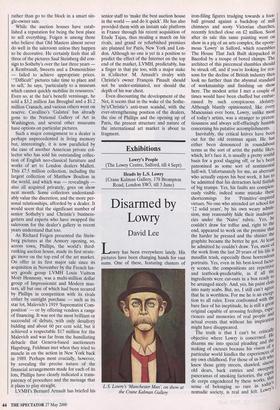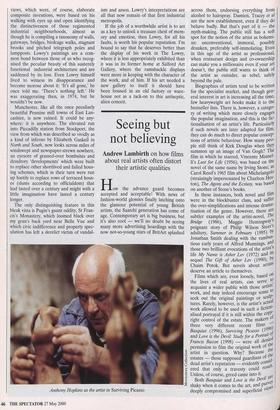Exhibitions
Lowry's People (The Lowry Centre, Salford, till 4 Sept) Heads by L.S. Lowry (Crane Kalman Gallery, 178 Brompton Road, London SW3, till 3 June)
Disarmed by Lowry
David Lee
Lowry has been everywhere lately. His pictures have been changing hands for vast sums. One of these, featuring clusters of L.S. Lowry's Manchester Man, on show at the Crane Kalman Gallery iron-filing figures trudging towards a foot- ball ground against a backdrop of mill chimneys and sooty Victorian churches, recently fetched close on £2 million. Soon after its sale this same painting went on show in a pig of an arts complex, the epony- mous 'Lowry' in Salford, which resembles The House That Jack Built skinpacked in Bacofoil by a troupe of bored chimps. The architect of this piecemeal shambles should be struck off, and if you're looking for rea- sons for the decline of British industry then look no further than the abysmal standard of workmanship and finishing on show here. The modest artist I met a couple of times would have been chuffed but embar- rassed by such conspicuous idolatry. Although bluntly opinionated, like every Mancunian ever born, Lowry, unlike most of today's artists, was a stranger to preten- tiousness and always self-effacingly humble concerning his putative accomplishments. Inevitably, the critical knives have been out for the old rentman again. He has either been denounced in roundabout terms as the sort of artist the public likes, which, let's face it, is usually a pretty sound basis for a good slagging off, or he's been patronised as some sort of sentimental half-wit. Unfortunately for me, an aberrant who actually enjoys his best work, it has to be admitted that his detractors hold fistfuls of big trumps. Yes, his faults are conspiew ously visible, indeed some mistake these shortcomings for 'Primitive'-inspired virtues. No one who attended art school for `12 solid years', by his own weary admis- sion, may reasonably hide their inadequa- cies under the 'Naïve' rubric. Yes, he couldn't draw for toffee and, right to the end, appeared to work on the premise that the harder he pressed and the shinier the graphite became the better he got. At least he admitted he couldn't draw. Yes, most of the work from the last 20 years of his life Is maudlin trash, especially those horrendous portraits. Yes, even in his best-loved facto- ry scenes, the compositions are repetitive and textbook-predictable, as if all the ingredients were cut-outs in a box ready to be arranged nicely. And, yes, his paint clots into nasty scabs. But, no, I still can't agree that he is worthless. For me he is an exceP" tion to all rules. Even confronted with Met bare face of his ineptitude, he is still a Brea original capable of arousing feelings, eVd riences and memories of real people an actual events that without his inspiration might have disappeared. The truth is that I can't be critically objective where Lowry is concerned. He disarms me into special pleading and tglia making of excuses because his vision 01 f particular world kindles the experiences fo my own childhood. For those of us ,11 knew those gritty streets, shawled, old dears, back entries and sweePinit panoramas of smoking factories, the esprit de corps engendered by these works, t" ,5 sense of belonging so rare in today'snomadic society, is real and felt. Low" views, which were, of course, elaborate composite inventions, were based on his walking with eyes up and open identifying the distinctiveness of those regimented industrial neighbourhoods, almost as though he is compiling a taxonomy of walls, gateways, bridges, birdcage walks, stagnant brooks and pitched telegraph poles and lampposts. Lowry's paintings are a com- mon bond between those of us who recog- nised the peculiar beauty of this austerely functional industrial architecture and are saddened by its loss. Even Lowry himself lived to witness its disappearance and become morose about it: 'It's all gone,' he once told me. 'There's nothing left.' He was exaggerating then, in 1974, but he wouldn't be now.
Manchester, like all the once peculiarly beautiful Pennine mill towns of East Lan- cashire, is now ruined. It could be any- where: it is anywhere. The elevated run into Piccadilly station from Stockport, the view from which was described so vividly as a kind of inferno by Elizabeth Gaskell in North and South, now looks across miles of windswept and newspaper-strewn nowhere, an eyesore of grassed-over bombsites and desultory 'developments' which were built to replace other shortlived and failed hous- ing schemes, which in their turn were run up hastily to replace rows of terraced hous- es (slums according to officialdom) that had lasted over a century and might with a little imagination have lasted a century longer.
The only distinguishing feature in this bleak vista is Pugin's gaunt oddity, St Fran- cis's Monastery, which loomed black over my gran's back yard near Belle Vue and which civic indifference and property spec- ulation has left a derelict victim of vandal- Anthony Hopkins as the artist in Surviving Picasso ism and arson. Lowry's interpretations are all that now remain of that first industrial metropolis.
If the job of a worthwhile artist is to act as a key to unlock a treasure chest of mem- ory and emotion, then Lowry, for all his faults, is worth his popular reputation. I'm bound to say that he deserves better than the display of his work in The Lowry, where it is less appropriately exhibited than it was in its former home at Salford Art Gallery, where the ramshackle displays were more in keeping with the character of the work, and of him. If his art needed a new gallery to itself it should have been housed in an old factory or ware- house not as a tack-on to this antiseptic, alien conceit.



































































 Previous page
Previous page